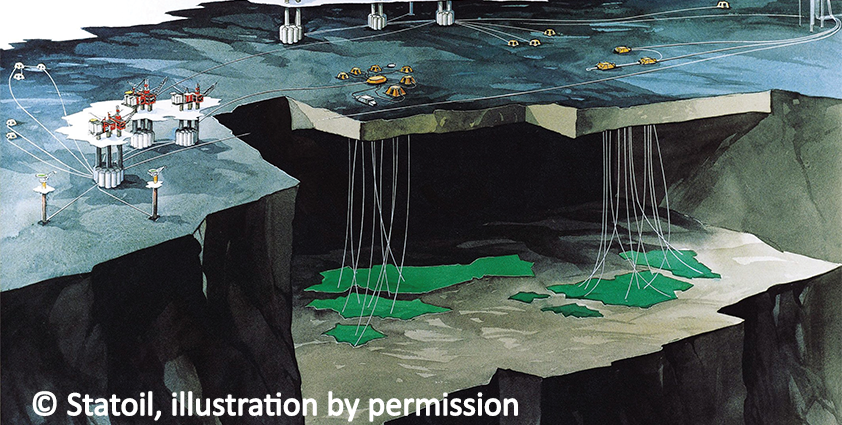
Statoil ASA
New prospects
Whilst the name Statoil is internationally recognised as a leading player in the energy market, the Group’s biggest activities are located in Norway where it is the largest operator on the Norwegian continental shelf (NCS), and a license holder in numerous oil and gas fields.
Onshore facilities within the country are active in areas such as gas treatment, crude oil reception, refinement and methanol production. Statoil also has the technical responsibility for the worlds most extensive subsea pipeline system for the transport of gas.
Beyond its centralised operations, Statoil is equally expansive in terms of its international presence, with offices in more than 34 countries worldwide. Whilst this provides the Group with access to new and emerging opportunities in terms of oil and gas resources, its close proximity to mature fields such as the North Sea continues to offer viable prospects.
Most notable is Statoil’s recent oil discovery in the Krafla West field in the North Sea, located approximately 26 kilometres southwest of Oseberg South. This breakthrough comes only a month after a discovery of similar size in the neighbouring structure Krafla. Made in conjunction with Statoil’s partners Det Norske Oljeselskap ASA and Svenska Petroleum Exploration AS, the Krafla West discovery well found hydrocarbons in two columns with a total gross thickness of 300 metres. Preliminary calculations indicate that the field contains some 13 – 38 million recoverable barrels of oil equivalent (boe).
Both the Krafla and Krafla West fields lie in the same area as Stjerne, formerly Katla. Having been proven in 2009, this region is already covered in a plan for development and operation from Statoil. A fast-track development of both the Krafla and Krafla West discoveries through tie-backs to existing infrastructure in the Oseberg area is currently being considered.
In another major development, earlier this year Statoil awarded Songa Offshore a contract for the construction of two new drilling rigs for use on the NCS. Capable of operating in 100 to 500 metre water depths, the specially designed category D drilling rigs can be used to develop wells of up to 8500 metres. Primarily these rigs will be used on mature fields for the drilling and completion of production wells, enabling Statoil and its partners to produce more oil, and therefore extend the life of these fields.
The rig concept itself has been developed in co-operation with a hull designer, several topside suppliers, and rig entrepreneurs. In total, the entire project concept and design process has taken one year with the implementation period expected to take approximately three years resulting in a scheduled delivery date of late 2014. The fixed contract period for each rig is eight years, with four options to extend this by an additional three-years. In practice, this could result in a 20-year contract for each rig. By taking this long-term approach, Statoil is able to ensure that it has the rig capacity needed to fulfil its growth ambitions.
Representing the cornerstone of Norwegian gas production, as well as one of the largest oil fields on the NCS, the Troll field will be the first to be serviced by the new rigs. In support of these activities Statoil has also signed a new contract with Songa Offshore for the continued hire of the semi-submersible rig – Songa Trym. This conventional exploration rig has been in use on the Troll field since 2005, where it has helped to realise planned drilling activities in the area. With the contract developed around Statoil’s exploration prospects on the NCS, the Songa Trym is chartered for work on the Troll field until Q2 2012, before being deployed to drill new exploration wells. In this respect the rig will also be considered for operation on several other licences.
As the North Sea and NCS markets continue to mature, so do the long-term assets and infrastructure located there. In recognition of this Statoil regularly undertakes planned maintenance turnarounds and upgrades on its oil and gas fields. These turnarounds are vital to allow maintenance, modification and inspection works to be carried out in order to maintain safety and efficiency and are something that Statoil always carries out at its facilities. Due to the nature of these works, each installation has to be shutdown prior to implementation.
For the Group, 2011 is no exception and this is reflected in plans to undertake one such programme on a number of installations in the NCS to make them safer and more robust, as well as improve production regularity, phase in new field developments, and extend their operational life. In order to minimise loss of production and subsequent costs, Statoil has carried out strict planning and preparation works prior to the instigation of the programme in June, with Troll A being the first platform to undergo a turnaround. This is to be followed by planned shutdowns at Snøhvit, Kvitebjørn, Visund, Statfjord C, and Gullfaks A and B in the weeks ahead.
By the end of October Statoil will have completed a total of 23 turnarounds on various installations and plants operated in Norway. The turnarounds also offer an ideal opportunity for the finalisation of Statfjord late life project, which will help extend the life of Statfjord C. During the shutdown tasks such as upgrading the system that controls production and safety systems will be carried out in order to modernise operation and improve working conditions for control room staff.
As a business that has grown alongside the emergence of the Norwegian oil and gas industry, Statoil is not only maintaining its contribution to that local market through innovative development of mature prospects, but is also applying that expertise to its considerable international interests. In this respect, the Statoil name remains synonymous with global energy supply, both now and for the years ahead.
Statoil ASA
Services: Oil and gas exploration and production